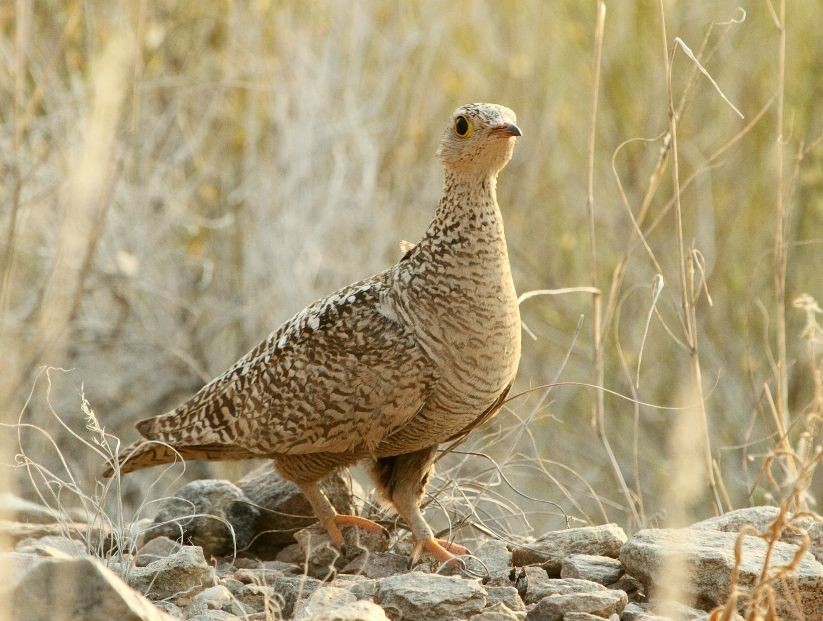Double-banded Sandgrouse
A species of Sandgrouse Scientific name : Pterocles bicinctus Genus : Sandgrouse
Double-banded Sandgrouse, A species of Sandgrouse
Botanical name: Pterocles bicinctus
Genus: Sandgrouse
Content
Description General Info
 Photo By Alan Manson , used under CC-BY-SA-2.0 /Cropped and compressed from original
Photo By Alan Manson , used under CC-BY-SA-2.0 /Cropped and compressed from original Description
A moderate sized bird with a plump body, the double-banded sandgrouse has a small pigeon-like head and long wings and tail. The general colour of the plumage is light brown with darker mottling and rows of whitish specks. The male is distinguished by having a conspicuous black and white band on its forehead and a chestnut throat area delineated by another black and white band. Both sexes have an area of bare yellow skin surrounding their eye and the male has an orange beak. The female is smaller and duller in colour. The juvenile resembles the female. 
Size
25 cm
Nest Placement
Ground
Feeding Habits
Double-banded Sandgrouse primarily consumes seeds, foraging mostly in the early morning and late afternoon. Unique for being largely inactive during the day, double-banded Sandgrouse has adapted to drinking at night.
Habitat
Double-banded Sandgrouse typically inhabits regions characterized by open landscapes such as grasslands and savannas with scattered trees or light woodland. Specifically, they are partial to areas with short grass, gravely terrain, and spots of scanty vegetation under occasional trees like Terminalia sericea and Burkea africana. Double-banded Sandgrouse is also found in regions with bushveld and mopane woodland, often in stony or rocky areas, and is adapted to environments ranging from sub-deserts to wooded zones with Brachystegia species.
Dite type
Granivorous
General Info
Feeding Habits
Bird food type
Behavior
The diet consists largely of seeds including acacia, red pea (Requenia sphaerosperma), Tephrosia, Cyperus, blackjack (Bidens bidentata) and hairy thorn-apple Datura innoxia. Breeding takes place between February and September, peaking earlier in the northern part of the range than the south. The male has a courtship display in which he walks round in circles with his beak near the ground and his tail raised high. The nest is a shallow depression in the soil, lined with a few bits of dried vegetation, often hidden between grass tufts or under a bush. Two or three eggs are laid and both sexes take it in turn to incubate them. They hatch in about 24 days. The chicks are precocial, being active with eyes open and clothed in fluffy down as soon as they are hatched. In about a month they have grown adult-type feathers and can fly. The double-banded sandgrouse is most often seen in groups of one to five birds, often two or four. The birds are monogamous and these are probably pairs or family units. In the morning they tend to feed in dry areas well away from water but in the afternoon they are most often seen near watering places. They visit water again, often in larger groups of up to 10, after dark. In Borakalalo Game Reserve, South Africa they were observed at dry times of year, in February and March and again between July and September. They were absent from the park during the wet summer period, from September to January. 
Distribution Area
The double-banded sandgrouse is found in Angola, Botswana, Malawi, Mozambique, Namibia, South Africa, Zambia and Zimbabwe. It has a preference for short trampled grass beside roads and tracks, gravel patches, tussocky grassland and recently burned areas of scrub with green shoots starting to develop. It is also seen in areas of scanty vegetation beneath scattered Terminalia sericea and Burkea africana trees and in scrubby mopane woodland. It is less common than Burchell's sandgrouse (Pterocles burchelli) and Namaqua sandgrouse (Pterocles namaqua), both of which have an overlapping distribution in southern Africa. 
Species Status
Not globally threatened.
Scientific Classification
Phylum
Chordates Class
Birds Order
Sandgrouse Family
Sandgrouse Genus
Sandgrouse Species
Double-banded Sandgrouse